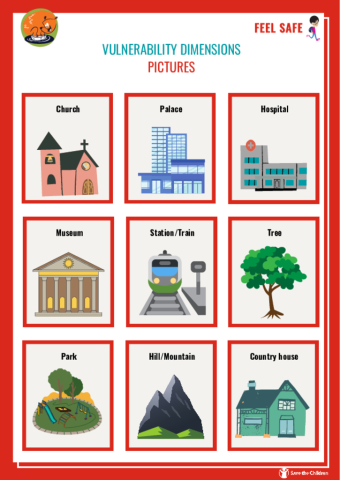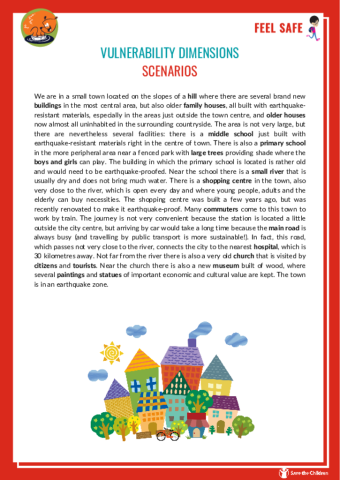Vulnerability dimensions
Objectives:
- Understand the dynamic aspect of vulnerability
- Promote awareness of the role played by vulnerability in determining risk and damage in different contexts
- Develop the ability to analyze and assess vulnerability in different scenarios
STEP BY STEP
BEFORE STARTING
The teacher introduces the definition of vulnerability Propensity to suffer damages from an event contained in the glossary then asks the class to indicate an element, a place or any image that comes to mind that represents vulnerability.
Vulnerability - propensity to suffer damages from an event.
The concept of vulnerability encompasses several elements, susceptibility The ability to suffer effects of a disaster and change due to these effects (which acts negatively on vulnerability, causing it to increase), resilience The ability to cope with calamitous events and overcome their effects (which acts positively on vulnerability, causing it to decrease) and exposure. For example, the students of a school located in a high seismic risk The possibility that a phenomenon may cause harm to people, settlements and the environment in a given period of time and in a given area zone are exposed to the earthquake Sudden ground shaking resulting from movements of the earth’s crust . If the building in which the school is located was built many years ago and with materials with low earthquake resistance, the students are vulnerable. If, however, the building is earthquake-resistant and teachers and pupils know the correct behaviour to adopt in the event of an earthquake, the vulnerability value decreases and, consequently, the risk to which they are exposed is lower. Similarly, the possibility of damage to the school building will also be much lower. This means that strategies can be put in place to decrease susceptibility and increase resilience, so that the overall value of the vulnerability of people and elements decreases.
Vulnerability can be measured through the use of numerical indices. An example of how the children's climate vulnerability index is calculated can be found in the document The climate crisis is a child rights crisis (link).
WHO IS MOST VULNERABLE?
The teacher introduces the activity by showing the class a few pictures (the number may vary depending on the class) of places, monuments, people, etc. with a title. The pictures are placed on the desk for the class to observe.
For example, the pictures may depict:
- A church
- A palace
- A hospital
- A museum
- A station/train
- A tree
- A park
- A hill/mountain
- A country house
- A school
- A road
- A shopping centre
- Children
- People
The class is divided into groups of 4 or 5 people and each group will have to work together to classify the pictures shown by the teacher by writing the title of the pictures on a sheet of paper. The same colour will be used for each image by each group (e.g. the word church will be written with blue for all groups, the word museum with green and so on).
The teacher describes a scenario and each group has to write in smaller characters the element they consider least vulnerable and in larger characters the elements they consider most vulnerable, until they have the largest characters for the element they associate with the greatest vulnerability Propensity to suffer damages from an event .
The vulnerability association activity is repeated for several scenarios. The teacher can describe his or her own scenarios (chosen on the basis of the images he or she intends to present to the class) or use the scenarios in the attachment "Vulnerability dimensions - Scenarios" (below) and the associated pictures in the attachment "Vulnerability dimensions - Pictures" (below).
VULNERABILITY IMAGES
Once the game is over, each group should arrange the words on a bench in ascending order for each scenario. The result is that for each scenario, the words will have a different order and size and each group will have to share their choices with the class.
CONCLUDING THOUGHTS
With the teacher, the class reflects on the concept of vulnerability Propensity to suffer damages from an event and how context and scenario influence a person's vulnerability. The teacher can guide the activity by helping groups think about the concepts of exposure, susceptibility The ability to suffer effects of a disaster and change due to these effects and resilience The ability to cope with calamitous events and overcome their effects by asking some stimulus questions.
- Are boys and girls in primary and secondary schools vulnerable?
- Are there elements that make them more or less exposed or susceptible to risk The possibility that a phenomenon may cause harm to people, settlements and the environment in a given period of time and in a given area ?


Add new comment